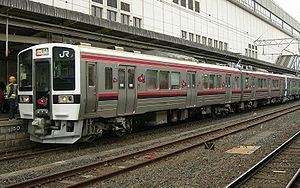Native name 磐越西線 Stations 44 Operator(s) JR East | Opened 1898 Line length 175.6 km (109.1 mi) | |
 | ||
Terminis | ||
The Banetsu West Line (磐越西線, Ban'etsu-sai-sen) is a railway line in Japan operated by East Japan Railway Company (JR East). It connects Kōriyama Station in Kōriyama, Fukushima and Niitsu Station in Niigata, Niigata. The name "Banetsu" is taken from the first characters of the names of the ancient provinces of Iwaki (磐城) and Echigo (越後), which the Banetsu East and Banetsu West lines connect. "Sai" (西) means "west" in Japanese.
Contents
- Station list
- Rolling stock
- KriyamaKitakata
- Aizu WakamatsuNiitsu
- Past
- History
- Future developments
- References
The line's nickname is the Mori to Mizu to Roman no Tetsudō (森と水とロマンの鉄道, lit. "the water, forest, and nostalgia railway").
Station list
Rolling stock
As of October 2016, the following rolling stock is used on the Banetsu West Line.
Kōriyama—Kitakata
From 25 April 2015, a two-car 719 series set entered service on FruiTea (フルーティア) services on the line between Koriyama and Aizu-Wakamatsu. The train accommodates 36 passengers.
Aizu-Wakamatsu—Niitsu
On May 15, 2015, JR East announced that it was placing an order for new diesel multiple unit (DMU) trains to be introduced from fiscal 2017.
Past
History
The Banetsu West Line was planned under the Railway Construction Act in 1892, and the private Ganetsu Railway opened the initial section from Kōriyama to Nakayamajuku on July 26, 1898, and extended the line to Aizu-Wakamatsu the following year. In 1906, when the line was extended to Kitakata, the Japanese Government Railways (JGR) nationalized the Ganetsu Railway and renamed the line the Ganetsu Line.
In 1910 the JGR opened the Niitsu - Maoroshi section and extended the eastern section to Yamato. The remaining sections were opened in 1913 and 1914, providing the first rail link from Niigata to the east coast of Japan (and Tokyo). The line was renamed the Banetsu West Line in 1917, the year that the Matsuno tunnel (situated west of Kitakata) collapsed, blocking the line for 15 months, during which time a cableway operated to transfer freight and passengers walked around the blocked section. The reopened section permanently bypassed the tunnel.
Japanese National Railways (JNR) started to modernize the line in the 1960s, introducing the line's first limited express service (as a part of the Yamagata-bound Yamabata) in 1965 between Ueno Station in Tokyo and Aizu-Wakamatsu via the Tōhoku Main Line. In 1968 the train was renamed Aizu Yamabata, but from 1993 onward it was renamed Viva Aizu and ran only between Koriyama and Aizu-Wakamatsu. The train was finally discontinued as a limited express service in 2003.
In 1967, JNR electrified the section between Kōriyama and Kitakata at 20 kV AC.
In 2011 the line was closed for 15 days in March following the Tohoku earthquake, two days in April as a result of aftershocks, and for 10 weeks following torrential rain at the end of July.
Future developments
A new station, called Kōriyama-Tomita, is scheduled to be built between and Kōriyama and Kikuta stations. The new station will be unstaffed, and is scheduled to open in spring 2017.
